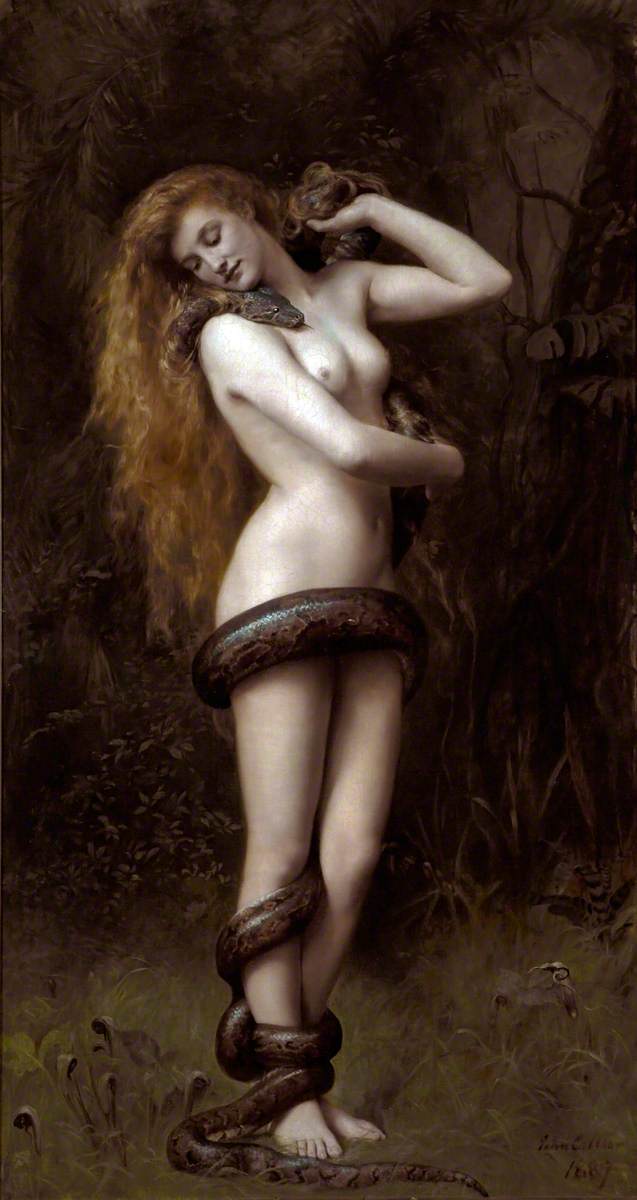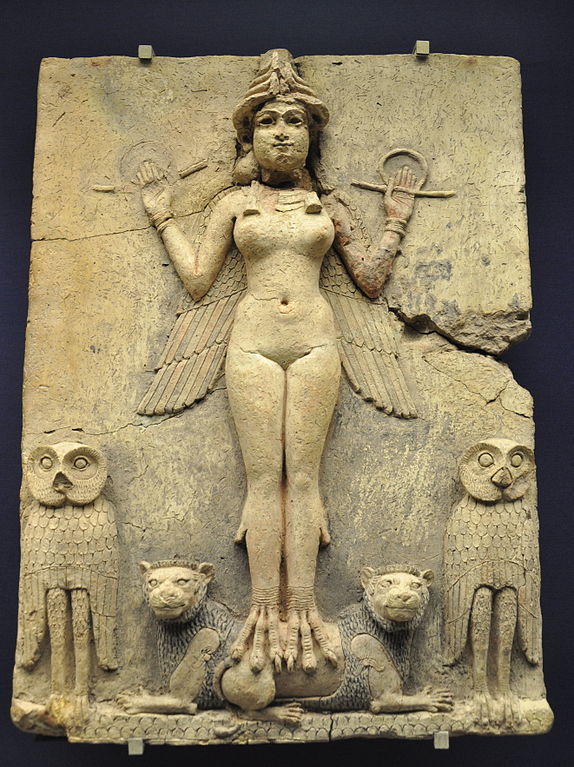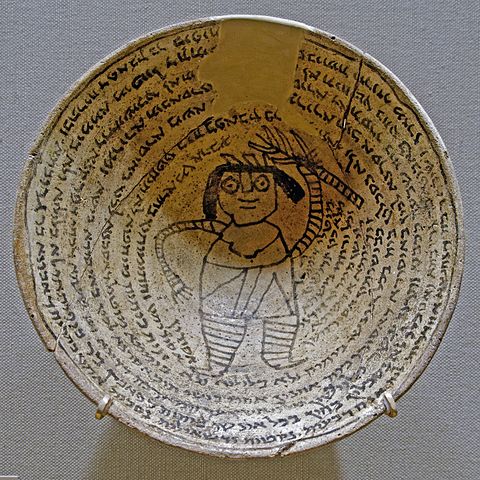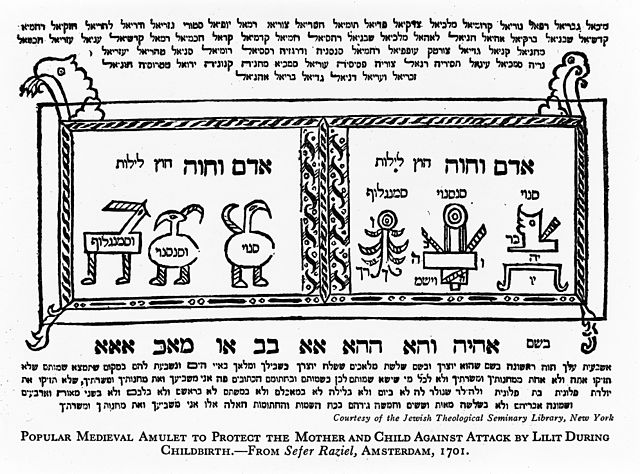Lilith
- This article is about the deity, for the qlippoth, see Lilith (qlippoth)
Lilith (Hebrew: לִילִית) is a female figure in Mesopotamian and Judaic mythology, theorized to be the first wife of Adam or a primordial demon. She is thought to be mentioned in the Biblical Book of Isaiah, and in Late Antiquity in Mandaean mythology and Jewish mythology sources from 500 CE onward.
Lilith appears in various concepts and localities that give partial descriptions of her. She is mentioned in the Babylonian Talmud (Eruvin 100b, Niddah 24b, Shabbat 151b, Baba Bathra 73a), in the Book of Adam and Eve as Adam's first wife, and in the Zohar as "a hot fiery female who first cohabited with man."
Many traditional rabbinic authorities, including Maimonides and Menachem Meiri, reject the existence of Lilith.
Name
The name Lilith stems from lilû, lilîtu, and (w)ardat lilî). The Akkadian word lilu is related to the Hebrew word lilit in Isaiah 34:14, which is thought to be a night bird by some modern scholars such as Judit M. Blair. In the Ancient Mesopotamian religion, found in cuneiform texts of Sumer, Assyria, and Babylonia, Lilith signifies a spirit or demon.
History
In some Jewish folklore, such as the satirical Alphabet of Sirach (c. 700–1000 AD), Lilith appears as Adam's first wife, who was created at the same time and from the same clay as Adam. The legend of Lilith developed extensively during the Middle Ages, in the tradition of Aggadah (rabbinic texts that incorporate folklore and historical anecdotes), the Zohar, and Jewish mysticism. For example, in the 13th-century writings of Isaac ben Jacob ha-Cohen, Lilith left Adam after she refused to become subservient to him and then would not return to the Garden of Eden after she had coupled with the Archangel Samael.
Interpretations of Lilith found in later Jewish materials are plentiful, but little information has survived relating to the Sumerian, Akkadian, Assyrian, and Babylonian view of this class of demons.
Recent scholarship has disputed the relevance of two sources previously used to connect the Jewish lilith to an Akkadian lilītu – the Gilgamesh appendix and the Arslan Tash amulets. In contrast, some scholars, such as Lowell K. Handy, hold the view that though Lilith derives from Mesopotamian demonology, evidence of the Hebrew Lilith being present is scant.
Mesopotamian mythology
The ki-sikil-lil-la-ke in Tablet XII of the Epic of Gilgamesh dated c. 600 BC is associated with a serpent and a zu bird and was rendered as "Lilith" by early translators. In Gilgamesh, Enkidu, and the Netherworld, a huluppu tree grows in Inanna's garden in Uruk, whose wood she plans to use to build a new throne. After ten years of growth, she comes to harvest it and finds a serpent living at its base, a Zu bird raising young in its crown, and that a ki-sikil-lil-la-ke made a house in its trunk. Gilgamesh is said to have killed the snake, and then the zu bird flew away to the mountains with its young, while the ki-sikil-lil-la-ke fearfully destroys its house and runs for the forest.
Kramer's translation of the Gilgamesh fragment was used by Henri Frankfort and Emil Kraeling in 1937 to support identification of a woman with wings and bird-feet in the disputed Burney Relief as related to Lilith. Frankfort and Kraeling identified the figure in the relief with Lilith. Today, the identification of the Burney Relief with Lilith is questioned. Modern research has identified the figure as one of the main goddesses of the Mesopotamian pantheons, most probably Ereshkigal. But the figure is more generally identified as the goddess of love and war.
The Arslan Tash amulets are limestone plaques discovered in 1933 at Arslan Tash, the authenticity of which is disputed. William F. Albright, Theodor H. Gaster, and others, accepted the amulets as a pre-Jewish source which shows that the name Lilith already existed in the 7th century BC but Torczyner identified the amulets as a later Jewish source.
Hebrew Bible
The word lilit (or lilith) only appears once in the Hebrew Bible, among a list of animals as part of a prophecy regarding the fate of Edom animals in Isaiah 34.
The Isaiah 34:14 Lilith reference does not appear in most common Bible translations such as KJV and NIV. Commentators and interpreters often envision the figure of Lilith as a dangerous demon of the night, who is sexually wanton, and who steals babies in the darkness. In the Dead Sea Scrolls 4Q510-511, the term first occurs in a list of monsters. Jewish magical inscriptions on bowls and amulets from the 6th century CE onward identify Lilith as a female demon and provide the first visual depictions of her.
The Septuagint translates both the reference to Lilith and the word for jackals or "wild beasts of the island" within the same verse into Greek as onokentauros, apparently assuming them as referring to the same creatures and omitting "wildcats/wild beasts of the desert" (so, instead of the wildcats or desert beasts meeting with the jackals or island beasts, the goat or "satyr" crying "to his fellow" and lilith or "screech owl" resting "there", it is the goat or "satyr", translated as daimonia "demons", and the jackals or island beasts "onocentaurs" meeting with each other and crying "one to the other" and the latter resting there in the translation).
The early 5th-century Vulgate translated the same word as "lamia."
Dead Sea Scrolls
The Dead Sea Scrolls contain one indisputable reference to Lilith in Songs of the Sage (4Q510–511) fragment 1:
And I, the Instructor, proclaim His glorious splendour so as to frighten and to te[rrify] all the spirits of the destroying angels, spirits of the bastards, demons, Lilith, howlers, and [desert dwellers] ... and those which fall upon men without warning to lead them astray from a spirit of understanding and to make their heart and their ... desolate during the present dominion of wickedness and predetermined time of humiliations for the sons of lig[ht], by the guilt of the ages of [those] smitten by iniquity – not for eternal destruction, [bu]t for an era of humiliation for transgression.
As with the Massoretic text of Isaiah 34:14, and therefore unlike the plural liliyyot in the Isaiah scroll 34:14, lilit in 4Q510 is singular, this liturgical text both cautions against the presence of supernatural malevolence and assumes familiarity with Lilith; distinct from the biblical text, however, this passage does not function under any socio-political agenda, but instead serves in the same capacity as An Exorcism (4Q560) and Songs to Disperse Demons (11Q11).
Joseph M. Baumgarten (1991) identified the unnamed woman of The Seductress (4Q184) as related to the female demon. However, John J. Collins regards this identification as "intriguing" but that it is "safe to say" that (4Q184) is based on the strange woman of Proverbs 2, 5, 7, 9:
Her house sinks down to death,
And her course leads to the shades.
All who go to her cannot return
And find again the paths of life.
- — Proverbs 2:18–19
Her gates are gates of death, and from the entrance of the house
She sets out towards Sheol.
None of those who enter there will ever return,
And all who possess her will descend to the Pit.
- — 4Q184
Jewish incantation bowls
An individual Lilith, along with Bagdana "king of the lilits", is one of the demons to feature prominently in protective spells in the eighty surviving Jewish occult incantation bowls from Sassanid Empire Babylon (4th–6th century AD) with influence from Iranian culture. These bowls were buried upside down below the structure of the house or on the land of the house, in order to trap the demon. Almost every house was found to have such protective bowls against demons.
The center of the inside of the bowl depicts Lilith, or the male form, Lilit. Surrounding the image is writing in spiral form; the writing often begins at the center and works its way to the edge. The writing is most commonly scripture or references to the Talmud. The incantation bowls which have been analysed, are inscribed in the following languages, Jewish Babylonian Aramaic, Syriac, Mandaic, Middle Persian, and Arabic. Some bowls are written in a false script which has no meaning.
The correctly worded incantation bowl was capable of warding off Lilith or Lilit from the household. Lilith had the power to transform into a woman's physical features, seduce her husband, and conceive a child. However, Lilith would become hateful toward the children born of the husband and wife and would seek to kill them. Similarly, Lilit would transform into the physical features of the husband, seduce the wife, she would give birth to a child. It would become evident that the child was not fathered by the husband, and the child would be looked down on. Lilit would seek revenge on the family by killing the children born to the husband and wife.
Key features of the depiction of Lilith or Lilit include the following:
- The figure is often depicted with arms and legs chained, indicating the control of the family over the demon(ess).
- The demon(ess) is depicted in a frontal position with the whole face showing.
- The eyes are very large, as well as the hands (if depicted).
- The demon(ess) is entirely static.
One bowl contains the following inscription commissioned from a Jewish occultist to protect a woman called Rashnoi and her husband from Lilith.
Alphabet of Ben Sira
The pseudepigraphical 8th–10th centuries Alphabet of Ben Sira is considered to be the oldest form of the story of Lilith as Adam's first wife. Whether this particular tradition is older is not known. Scholars tend to date the Alphabet between the 8th and 10th centuries AD. The work has been characterized by some scholars as satirical, but Ginzberg concluded it was meant seriously.
In the text an amulet is inscribed with the names of three angels (Senoy, Sansenoy, and Semangelof) and placed around the neck of newborn boys in order to protect them from the lilin until their circumcision. The amulets used against Lilith that were thought to derive from this tradition are, in fact, dated as being much older. The concept of Eve having a predecessor is not exclusive to the Alphabet, and is not a new concept, as it can be found in Genesis Rabbah. However, the idea that Lilith was the predecessor may be exclusive to the Alphabet.
The idea in the text that Adam had a wife prior to Eve may have developed from an interpretation of the Book of Genesis and its dual creation accounts; while Genesis 2:22 describes God's creation of Eve from Adam's rib, an earlier passage, 1:27, already indicates that a woman had been made: "So God created man in his own image, in the image of God created he him; male and female created he them." The Alphabet text places Lilith's creation after God's words in Genesis 2:18 that "it is not good for man to be alone;" in this text God forms Lilith out of the clay from which he made Adam but she and Adam bicker. Lilith claims that since she and Adam were created in the same way they were equal and she refuses to submit to him.
Although the image of Lilith of the Alphabet of Ben Sira is unprecedented, some elements in her portrayal can be traced back to the talmudic and midrashic traditions that arose around Eve.
Kabbalah
Kabbalistic mysticism attempted to establish a more exact relationship between Lilith and God. With her major characteristics having been well developed by the end of the Talmudic period, after six centuries had elapsed between the Aramaic incantation texts that mention Lilith and the early Spanish Kabbalistic writings in the 13th century, she reappears, and her life history becomes known in greater mythological detail. Her creation is described in many alternative versions.
The Zohar contains 48 references to her in numerous passage. It explicitly mentions her creation as being before Adam's, on the fifth day, because the "living creatures" with whose swarms God filled the waters included Lilith. A similar version, related to the earlier Talmudic passages, recounts how Lilith was fashioned with the same substance as Adam was, shortly before. A third alternative version states that God originally created Adam and Lilith in a manner that the female creature was contained in the male. Lilith's soul was lodged in the depths of the Great Abyss. When God called her, she joined Adam. After Adam's body was created a thousand souls from the Left (evil) side attempted to attach themselves to him. However, God drove them off. Adam was left lying as a body without a soul. Then a cloud descended and God commanded the earth to produce a living soul. This God breathed into Adam, who began to spring to life and his female was attached to his side. God separated the female from Adam's side. The female side was Lilith, whereupon she flew to the Cities of the Sea and attacked humankind.
Yet another version claims that Lilith emerged as a divine entity that was born spontaneously, either out of the Great Supernal Abyss or out of the power of an aspect of God (the Gevurah of Din). This aspect of God was negative and punitive, as well as one of his ten attributes (sefirot), at its lowest manifestation has an affinity with the realm of evil and it is out of this that Lilith merged with Samael.
An alternative story links Lilith with the creation of luminaries. The "first light," which is the light of Mercy (one of the Sefirot), appeared on the first day of creation when God said "Let there be light." This light became hidden and the Holiness became surrounded by a husk of evil. "A husk (klippa) was created around the brain" and this husk spread and brought out another husk, which was Lilith.
The western mystery tradition associates Lilith with the qlippoth of Kabbalah. Dion Fortune writes, "The Virgin Mary is reflected in Lilith," and that Lilith is the source of "lustful dreams." She is the ruler over Gamaliel, but there is also a sphere on the Tree of Death named Lilith (qlippoth).
Renaissance magic
Lilith is found in very few grimoires of Solomonic magic. The most well-known is the 15th century manuscript known as the Munich Manual of Demonic Magic. This book contains a ritual called the First Mirror of Lilith which allows a magician to gain hidden knowledge by means of a mirror engraved with sacred symbols and texts. This mirror is consecrated to Lilith and used as part of an invocation to summon her in a cemetery or at a crossroads.
Some scholars believe her name may be simply a misspelling of the Goetic demon Berith, but references to her as the "matron of night" and her "avian friends" seem to confirm that the ritual is intended to invoke Lilith.
As an occult figure
The depiction of Lilith in Romanticism continues to be popular among Wiccans and in other modern occult traditions. Many early occult writers who contributed to modern day Wicca expressed special reverence for Lilith. Gerald Gardner asserted that there was continuous historical worship of Lilith to present day, and that her name is sometimes given to the goddess being personified in the coven by the priestess. This idea was further attested by Doreen Valiente, who cited her as a presiding goddess of the Craft: "the personification of erotic dreams, the suppressed desire for delights."
In some contemporary concepts, Lilith is viewed as the embodiment of the Goddess, a designation that is thought to be shared with what these faiths believe to be her counterparts: Inanna, Ishtar, Asherah, Anath, Anahita and Isis. According to one view, Lilith was originally a Sumerian, Babylonian, or Hebrew mother goddess of childbirth, children, women, and sexuality. A few magical orders dedicated to the undercurrent of Lilith, featuring initiations specifically related to the arcana of the "first mother", exist. Two organisations that use initiations and magic associated with Lilith are the Ordo Antichristianus Illuminati and the Order of Phosphorus.
Lilith appears as a succubus in Aleister Crowley's De Arte Magica. Lilith was also one of the middle names of Crowley's first child, Nuit Ma Ahathoor Hecate Sappho Jezebel Lilith Crowley (1904–1906), and Lilith is sometimes identified with the goddess Babalon in Thelemic writings.
Many theistic Satanists consider Lilith a goddess. She is considered a goddess of independence by those Satanists and is often worshipped by women, but women are not the only people who worship her. Lilith is popular among theistic Satanists because of her association with Satan. Some Satanists believe that she is the wife of Satan and thus think of her as a mother figure. Others base their reverence for her on her history as a succubus and praise her as a sex goddess. A different approach to a Satanic Lilith holds that she was once a fertility and agricultural goddess.
Occultist Travis McHenry announced he is creating a tarot deck based on Lilith mythology drawing on sources from ancient times to the modern era. The deck, scheduled to be released in late 2025 or early 2026, is titled the Lilith Tarot.



